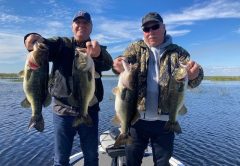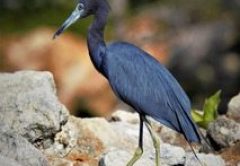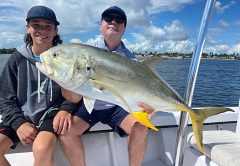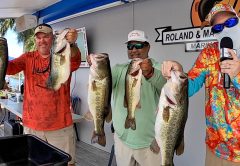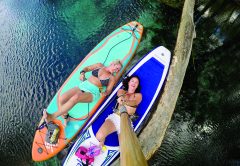Fenwick to Select 10 New Collegiate Anglers for Earn Your Wings Program
May 4, 216 – By FTR
Columbia, S.C. : Entering its fifth season, the Fenwick “Earn Your Wings” program has been wildly popular among collegiate anglers. Fenwick is alleviating the rising cost of tuition by giving anglers the opportunity to fish Fenwick and Pflueger products without spending money that is better used toward an angler’s education.
By selecting 10 student anglers, Fenwick continues to develop the collegiate angler. Earn Your Wings applications are set to open May 9, 2016 and will remain open until July 25, 2016.
Fenwick anglers will be selected based on academic performance, extracurricular activities, leadership skills, and overall fishing tournament participation.
One angler selected from the 2017 Earn Your Wings team will acquire an eight-week paid internship with Fenwick at their headquarters in Columbia, S.C.
“The Earn Your Wings program is a step for those individuals looking to break into the fishing industry,” said Zach Turner, Fenwick marketing coordinator. “Fenwick is committed to developing young anglers and giving them the opportunity to look beyond the pond. This is an opportunity for college anglers to showcase their creative skills.”
To apply for the Fenwick Earn Your Wings program, potential team members must submit an application that includes examples of their best photography in order to make the cut. After a lengthy selection process, the Fenwick Earn Your Wings team will be formed.
Throughout the year, each Fenwick angler will provide photo content that will later be used to influence others to participate in the sport of fishing.
The paid internship consists of marketing duties as well as product development for the brand. This one lucky angler, turned intern, will also have a heavy presence developing material for Fenwick’s digital outlets.
Garmin and Johnson Outdoors settle patent lawsuit
May 6th, 2016
By: FTR
Garmin International and Johnson Outdoors said today that the companies reached an agreement on a settlement that resolves a lawsuit involving Johnson Outdoors’ patented side scan sonar technology.
Today’s announcement follows International Trade Commission rulings affirming infringement by Garmin of one Johnson Outdoors patent and non-infringement of two Johnson Outdoors patents.
The agreement, which includes the licensing of these patents to Garmin, will bring closure to related legal matters pending before the ITC, the U.S. Court of Appeals for the Federal Circuit and U.S. District Court for the Middle District of Alabama.
Terms of the agreement are confidential.
“Innovation is our lifeblood and what Johnson Outdoors has delivered consistently for nearly 50 years,” Johnson Outdoors chairman and CEO Helen Johnson-Leipold said in a statement. “It is the driving force behind our legacy of continuous growth and success. This is why we invest heavily in development and protection of our proprietary innovation and vigorously defend it against unauthorized use. Today’s announced settlement and licensing agreement are the latest acknowledgements of the validity of our side scan sonar patents by our competitors, as affirmed consistently by the courts.”
“Garmin recognizes Johnson Outdoors and Humminbird’s innovation in side scan fishfinder technology,” Garmin International president and CEO Cliff Pemble said. “We understand that patents are a great accomplishment, a prized achievement by innovation leaders, including Johnson Outdoors and Humminbird. We are pleased with the amicable resolution of this matter and respect Johnson Outdoors for working with Garmin to license this technology.”
Sea Turtle Nesting Season Begins May 1st
By: FWC Diane Hirth
Sea turtle nesting season begins in May on many Florida beaches, including the sandy beaches of northwest Florida. The season lasts through the end of October and is the critical time when people can help keep sea turtles and hatchlings safe.
“In order to keep sea turtles and our beaches and oceans healthy, it’s important for all of us to be good neighbors and do our part,” said Dr. Robbing Trindell, who leads the sea turtle management program at the Florida Fish and Wildlife Conservation Commission (FWC).
The FWC recommends residents and visitors in northwest Florida and all coastal communities follow a few simple guidelines in order to help conserve sea turtles and their hatchlings. Beach resident and visitors are encouraged to follow these tips:
Do Not Disturb. During nesting season from May to October, it’s important to keep your distance from nesting sea turtle, their nests, whether eggs are visible or not, and their hatchlings. In northwest Florida, nest are usually marked with distinctive yellow signs and tape, but not always. Please don’t shine lights on sea turtles or hatchlings or take photos of them – including cell phone photos.
Use the Right Light to Help Them at Night. Turn off or adjust lighting along the beach in order to prevent nesting females or hatchlings from getting confused and going towards lights on land instead of the salt water, where they belong. Use turtle-friendly lighting on outside lights on homes and other buildings along the beach. Replace incandescent, fluorescent and high-intensity bulbs with FWC-certified low-wattage, long wavelength options available in red or amber colors. Turn out outdoor lights at night when not needed.
Remember with beach lighting to:
- Keep It Long: Long wavelength lights are better for turtles. Look for the red and amber lights that have been certified as turtle friendly by FWC
- Keep It Low: Illuminate walkways by installing lights close to the ground.
- Keep It Shielded: Focus lights down, not up or outward, to avoid confusing nesting turtles and hatchings.
- Shut Curtains and Blinds: Close curtains and draw blinds at night on beachfront windows and doors.
Clear the Way at the End of the Day. Nesting mothers and hatchling sea turtles can get trapped or confused by beach furniture left on the beach at night. Beach furniture also can cover sea turtle nesting areas. Please bring furniture, such as beach chairs, umbrellas, buckets and tents, back to your house, condo or hotel at the end of the day and fill in holes or level piles of sand before nightfall. Also please avoid burying umbrella poles in the sand; use pole holders or sleeves instead.
Properly dispose of any trash, food or other litter in covered trash cans to avoid attracting predators to the nests.
Lastly, report sick, injured, entangled or dead sea turtles to the FWC’s Wildlife Alert Hotline: 1-888-404-3922. For more on Florida’s sea turtles, visit www.MyFWC.com/SeaTurtle.
Tamiami Trail Bridge Expansion
On April 22, Earth Day, ground was broken on a 2.6-mile project bridging another section of the Tamiami Trail that ultimately will aid in the sheet flow south into Everglades National Park. The Tamiami Trail is the southernmost 275 mile stretch of U.S. Highway 41 from route 60 in Tampa to US 1 in Miami.
The U.S. Department of Transportation deputy secretary was in South Florida to announce more improvements to the Tamiami Trail, which will allow more water to flow into Everglades National Park. “Today we are announcing the awarding of a $20 million grant to help replace part of the Tamiami Trail with a new two-and-a-half-mile elevated bridge,” said DOT Deputy Secretary Victor Mendez.
For 75 years, the Tamiami Trail has connected one side of Florida to the other, and cut off the natural flow of water into Everglades National Park. “The 2.6-mile western bridge we will now build will work in tandem with the one-mile eastern bridge that we just completed, re-hydrating the east Everglades area that is dying of thirst,” said Everglades National Park Superintendent Bob Krumenaker. “It will also provide a path to move water south from Lake Okeechobee.”
The Federal Department of Transportation is awarding $20 million for the new bridge and the state of Florida has already kicked in $90 million.
“By uncorking this road we allow that water from Lake Okeechobee to flow through the central parts of the Everglades into Everglades National Park, which unfortunately is starved for water,” said Everglades Foundation CEO Erik Eikenberg.
The total cost of the bridge project is $180 million.
Zoom Releases Z Craw Jr
Bogart, Ga
Zoom Bait Company announced the release of the new Z Craw Jr., a downsized version of the popular ribbed crawfish lure introduced last year to overwhelming acceptance. Zoom has shrunk the original model down from five inches to three and a half inches for times when bass demand a smaller bite, yet they have retained the same forward facing ribs and fluttering craws of the full sized Z Craw.
In its single year of existence, the Z Craw found a purpose not only in punching the thickest cover around, but also on the back of swim jigs and vibrating jigs, as well as structure-hugging wobble heads. This new smaller version will handle all of those same applications, and will quickly turn into a favorite lure for tempting finicky bedding bass as well. It’s smaller than its predecessor, and while it has finesse applications, the company says anglers will be surprised at how many big bass it fools.
Currently, the Z Craw Jr. is available in 13 of Zoom’s most popular and universally applicable colors. Look for it soon at leading tackle stores and online retailers.
[easy-social-share]


